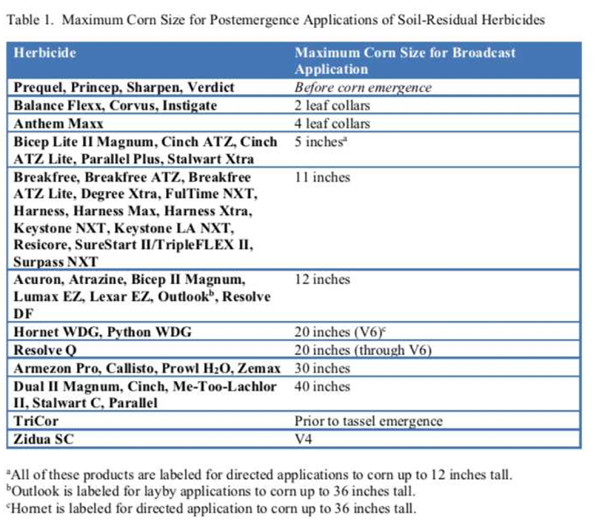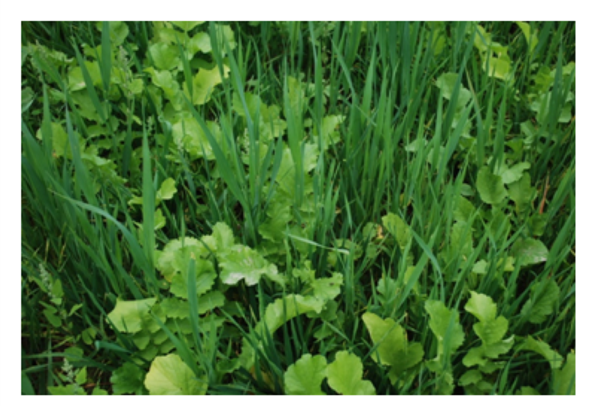Brought to you by: Jonah T. Johnson, MS, CPAg, CCA - Sales Agronomist, PCT | Sunrise
June 10, 2019: Residual Herbicide “Post-Application” Cutoffs and “Prevent Plant” Resources
Residual Herbicide “Post-Application” Cutoffs
With the onset of corn planting and the sense of urgency to initiate #plant19, some growers are in the situation of having no burndown herbicide application completed prior to corn planting. Others have emerged corn and have not applied an herbicide application. One class of herbicides we do not want to eliminate are the residual herbicides.
In late-planted corn, residual herbicides may be effective enough to reduce need for POST herbicides. Or the residuals could be applied early POST, after the rush to plant is over (keeping rotation guidelines in mind). Some corn fields are already in this situation, planted without any herbicide applied yet. The table below shows restrictions on POST use of residual corn herbicides (source – U of Illinois). This information can also be found in the herbicide descriptions in the Weed Control Guide , and is also summarized in this PSU newsletter article and this table from the MSU weed control guide.
Reminder that use of 28% UAN as a spray carrier is prohibited for POST application of herbicides with the exception of Degree Xtra.
“Prevent Plant” Resources
Wet weather continues to delay planting in some parts of Ohio. Regarding corn planting, June 5th (or June 20th for soybeans) was the last day to you are eligible for your full guarantee at the level you have selected for your crop insurance policy. If you elect to plant corn after June 5th, you will incur a 1% reduction in your guarantee up through June 25, at which time you can choose not to insure your corn crop or you can insure for the same guarantee as your prevent plant amount.
By now, many growers have already made the decision on what fields will go into “preventive planting.” For us as agronomic advisors, we need to have plans in place to help our growers who will have no crops planted on some of their ground.
Cover Crops for Prevented Planting Acres
Excessive spring rainfall and prolonged ponding conditions often mean some fields remain unplanted to corn or soybeans. These “prevented planting” acres, while unfortunate for the current year’s production, should be managed to prevent further soil degradation and increase soil productivity for next year.
Planting cover crops on prevented planting acres protects the soil from further water and wind erosion. Just as important, high-biomass cover crops help build soil organic matter, improve soil aggregation, and stimulate soil biological activity by adding their roots and shoots to the soil. Fibrous roots enmesh soil particles and provide food for microorganisms, which in turn produce polysaccharides and other “sticky” substances that stabilize soil aggregates.
Cover crops also provide food for beneficial soil fauna such as earthworms. Cover crop roots and the soil biological activity they promote also increase soil porosity and decrease density near the soil surface, which improve infiltration into the soil. Both the root growth and top growth of the cover crops will contribute to building soil organic matter faster than if the soil is left bare or left to weeds.
Some popular options for our current situation would be oats and forage radishes or turnips. Often, a mix of cover crops provides more benefits than a single species, and producers should consider a mix that includes two or three. These species mix stimulate soil biological activity more quickly because there is greater diversity of crop and root types. Mixing a fibrous-rooted grass and a legume or brassica with a taproot will improve soil throughout the soil profile.
Over the years, many growers have been successful using bin run ‘feed’ oats originating in Canada. Most of the concerns with utilizing ‘feed’ oats are obvious: no germination test, and the potential for bringing some weed seed onto the farm. Another problem experienced once was that a few of the Canadian oats in the “feed bin” were apparently winter oats. After getting started in the fall, they went dormant over winter, and then elongated in the spring much like winter wheat does after breaking dormancy.
University Resources for more in-depth information:
Cover Crops for Prevented Planting Acres: https://extension.purdue.edu/extmedia/AY/AY-355-W.pdf
Weed Management on Prevented Planting Acres: http://bulletin.ipm.illinois.edu/?p=4619
Current Weed Issues I: Controlling Weeds in Prevented Planting Areas: https://agcrops.osu.edu/newsletter/corn-newsletter/2019-15/current-weed-issues-i-controlling-weeds-prevented-planting-areas
Forage radish and oat mixture in late September after 50 days of growth.

